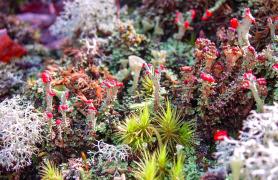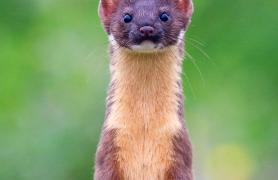Snowy Backyard
Don’t stay inside when the snow gets to blowing. Head out to discover nature coming and going.
Listen
Northern mockingbirds typically know between 50 and 200 songs. They mimic other birds with pitch-perfect precision and have been known to imitate barking dogs, croaking frogs, car alarms, and cellphones. The loudbeaked birds start singing in February and don’t shut up until November.
What Happened Here?
Your parents probably warned you never to eat yellow snow. Well, don’t eat other-colored snow, either. Cottontail rabbits tinkle pink, red, orange, or brown. The off-colored urine is caused by pigments in plants the rabbit has eaten.
Look
Two kinds of tree squirrels scamper through the branches of Missouri. Although they look similar, there’s an easy way to tell them apart: Fox squirrels have reddish-brown bellies. Gray squirrels have white bellies.
Do More
Place your used Christmas tree under a bird feeder. It will offer birds shelter from the wind and a place to escape to when the neighbor’s cat comes prowling.
Did You Know?
Although it’s no bigger than the “S” in “small,” a snow flea can spring 4 inches into the air. If it were human sized, it could leap over a 20-story building!
Look
In warmer months, eastern bluebirds stuff their beaks with caterpillars, beetles, and other insects. But when bugs disappear in winter, bluebirds switch to eating berries.
Take a Closer Look
If you find tiny black specks in the snow at the base of a tree, it probably isn’t pepper. Tiny insects called snow fleas become active on sunny winter days. When a snow flea wants to flee, it releases its spring-loaded tail, and the flea flings forward.
What Happened Here?
If you find a tangle of tunnels in the grass under the snow, you’ve found the work of a vole. Voles are mouselike rodents with stubby tails. They snip grass to eat and build — mouthful by mouthful — a maze of tunnels.
Look
White-breasted nuthatches go nuts for nuts. The dart shaped birds are often seen creeping headfirst down tree trunks. They’re named for their habit of cramming nuts into bark and then pecking them open to “hatch” out the seed.
Also In This Issue


This Issue's Staff
Les Fortenberry
Karen Hudson
Angie Daly Morfeld
Noppadol Paothong
Marci Porter
Mark Raithel
Laura Scheuler
Matt Seek
David Stonner
Nichole LeClair Terrill
Stephanie Thurber
Cliff White






















